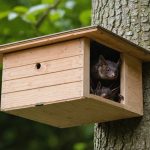As a UK resident, you might occasionally come across a group of bats fluttering around your home or garden. Your initial reaction might be one of surprise or concern, but it’s important to note that bats play a crucial role in our ecosystem. They help in the control of pests, pollination of flowers, and seed dispersal, thereby aiding in natural conservation. Therefore, maintaining bat-friendly environments, such as bat boxes, is essential for their survival. Here, we will delve into the guidelines you should follow in constructing bat boxes in your vicinity, along with understanding bat surveys, building planning, and bat habitat conservation.
Understanding the Importance of Bat Surveys
Before starting any development project that might affect bats’ natural roosts, it’s crucial to conduct a bat survey. A bat survey is a study carried out to ascertain the presence or likely absence of bat species within a site or building.
Avez-vous vu cela : Balancing Conservation and Adventure: The Role of Eco-Tourism in Protecting UK”s Fragile Ecosystems
Why is this important, you might ask? The presence of bats or their roosts can significantly affect planning decisions and the timescales of your development project. This is because all bat species, their roosts and breeding sites are legally protected under UK law. This means it’s an offence to intentionally or recklessly disturb bats in their roosts, or to damage or destroy a bat roost.
A bat survey will involve a detailed survey of the buildings or trees on your site, an assessment of any potential impacts to bats, and recommendations for mitigation if bats are found. The results of the survey should then be used to inform your development plans and any required mitigation measures.
Dans le meme genre : How are UK’s urban greening projects increasing bird diversity in city centers?
Planning the Location and Design of Bat Boxes
Once you’ve determined that your site is suitable for bat boxes, the next step is planning their location and design. Bats prefer dark, warm, and safe roosts, so your bat box should emulate these qualities.
Choose a site where the bat box will be exposed to sunlight for at least part of the day. This will ensure that the box remains warm. The box should be installed at least 4 to 5 metres above the ground, away from any potential predators.
The design of your bat box should also accommodate the specific needs of bats. It should be narrow and deep, simulating the cracks and crevices that bats naturally roost in. The entrance should be at the bottom, allowing bats to drop down and fly off, as this is their natural exit strategy from roosts.
Don’t forget to provide rough surfaces inside the box for bats to cling to. You can achieve this by grooving the wood, or by using a rough-sawn timber. Lastly, ensure that the bat box is watertight, as bats will avoid damp roosts.
Building the Bat Box
After planning, the next step is the actual construction of the bat box. Use untreated wood, as bats are sensitive to chemicals found in many wood treatments. The roof of the box should be sloping and covered with a waterproof material, such as roofing felt, to ensure that it remains dry.
To construct the box, start by cutting the wood according to your plan. Secure the pieces together using screws, ensuring that the joints are tight to prevent drafts. Once the box is assembled, make sure to drill some small holes at the bottom for drainage.
For the box’s interior, ensure that there are tight spaces for bats to roost. It’s recommended that you create chambers of different sizes to accommodate different species of bats. Also, remember to make the inside rough or grooved to give bats something to cling to.
Mitigation and Conservation
Building bat boxes is not just about providing roosts for bats. It’s also about contributing to bat conservation. This includes conducting regular surveys after the boxes are in place to monitor their use and effectiveness.
If you’re working on a development project, a bat survey should be part of your planning process. If bats are found, you will need to incorporate mitigation measures into your development plans to avoid harming them or their roosts. This can include adjusting your work schedule to avoid disturbing bats during their breeding season or designing your project to minimise impacts to bats and their habitats.
Remember, bats are a crucial part of our natural ecosystem. By building bat boxes and considering bats in your planning and development projects, you’re not just helping to conserve these interesting creatures, but you’re also playing a part in maintaining the health and balance of our natural environment.
Surveying the Bat Box Periodically
Once you have your bat box constructed, it’s not a case of ‘out of sight, out of mind’. Under guidelines provided by Natural England, it’s essential to carry out regular bat surveys to monitor the use and success of the box.
A bat survey of a bat box will not only help you understand how often and by which species the box is being used, but also if any adjustments or maintenance is needed. In some cases, a box may remain unoccupied for a year or more. Don’t be discouraged, as it often takes time for bats to find and colonise new roosts. Regular surveys will allow you to gauge the box’s effectiveness over time.
During these surveys, you’re likely to encounter different bat species, such as the crevice-dwelling species like pipistrelles. Remember, all bat species are protected species, so ensure minimal disturbance during the survey. In case you’re unsure about the process, it’s best to contact the Bat Conservation Trust. They provide advice and can conduct professional surveys.
Additionally, case studies can be found on the Bat Conservation Trust website, which provide insights into successful bat box projects. These can offer invaluable guidance, especially if you’re not getting the desired results.
Maintaining a record of your surveys and observations can be helpful for future reference and for other bat enthusiasts in your community. Sharing this data with local conservation groups can support wider conservation efforts.
(Image Credit: Bat Conservation Trust)
Conclusion: Every Bat Box Counts
In conclusion, erecting a bat box might seem like a small action, but it can have a significant impact on local bat populations. As UK residents, it’s our responsibility to ensure the survival of these fascinating creatures, who play such a crucial role in maintaining our ecosystem.
Should you consider building a bat house in your vicinity, always remember to conduct a bat survey before any construction to avoid disturbing existing bat roosts. The design and location of your bat box are key to making it appealing to bats. Regular surveys post-construction ensure that your bat box is effectively serving its purpose.
If you’re part of a larger development project, a planning application to local authorities should include a detailed bat survey report. Any presence of bats will need bat mitigation strategies to avoid any potential harm to these protected species.
Engaging with your local Conservation Trust can provide further guidance and support in your bat conservation efforts.
Remember, every bat box counts in our collective effort for bat conservation. They are not just houses for bats but are symbols of our commitment to preserving biodiversity and the health of our natural environment.
















